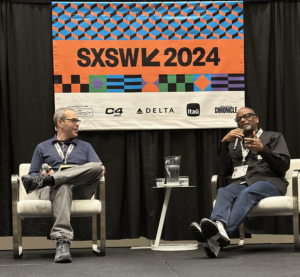Exploring Inclusivity through Footwear Design
Adam Allard and Dr. D’Wayne Edwards Discuss Shoe Design and Manufacturing as a Catalyst for Change
How do you innovate in an industry that hasn’t changed in 100 years? To explore what the answer means for Design and Make industries, Adam Allard, Senior Manager of Autodesk Research Technology Centers, recently hosted a fireside chat at SXSW Interactive with Dr. D’Wayne Edwards, President of PLC Detroit, the only design-focused Historically Black college and university (HBCU), and founder of JEMS, the first Black-owned athletic footwear company in the United States. During the conversation, the two discussed new approaches to workforce development, materials, and processes in design and manufacturing, as well as how JEMS benefits from the Autodesk Research Residency Program. We recently talked with Adam about his experiences in Austin.
Talk about your conversation with D’Wayne at SXSW and what you shared with attendees.
D’Wayne is a renowned designer who could be working at any of the top shoe manufacturers in the world. But he’s made a deliberate decision in his life to focus on education, workforce development, manufacturing, materials, and innovation in the footwear industry. One of my big goals was to let the audience know who he is and what he’s about.
We also talked about how JEMS works with Autodesk Research Residency Program to explore how to use innovative materials and processes in shoe design and manufacturing. Things like using 3D printing to make tools for developing shoes and talking about how to more sustainably use and reuse materials as part of a circular economy.
One of the goals of the fireside chat was to highlight impactful ways to drive change by exploring new approaches to workforce development, materials, and processes in design and manufacturing. How do you think Autodesk’s relationship with JEMS does this?
D’Wayne is critical of the education model and how things have been done for so many years. He believes that a better way is to understand what industry really needs and to then train students to be that future workforce. That’s what he’s doing with PLC Detroit by convincing corporations like Nike and Adidas to invest in the education of their future workforce.
I think if we look at our digital tools, it’s the same idea. We want to give our customers the tools they need to be relevant in the industry. By having JEMS team members come into our spaces at the Autodesk Technology Centers, utilize our tools, and see how it connects to their curriculum and how they’re learning to be contributors all goes hand in hand.
We’re also exploring how to be even more productive by leveraging AI. In manufacturing, there are a lot of questions around AI and whether that’s going to replace some roles. I think the bigger opportunity for AI is to create a better experience for people and a safer place to work on the factory floor, while also increasing productivity. I’m really encouraged and optimistic about the future and AI as it relates to manufacturing.
Can you talk about the mutually beneficial relationship of the Autodesk Research Residency Program both for Autodesk and companies like JEMS?
One of the big benefits for a company like JEMS to work with our Residency Program is being able to look at fabrication methodologies for an industry that really hasn’t changed in the last 100 years. For them to come in and see that they can use, for example, a water jet cutter to cut dies for shoes instead of doing it by hand. We can explore how to digitize some of those fabrication processes to help them with different iterations.
As a resident, JEMS also gets exposure to our engineering teams who can apply technology to industries in a unique way because they aren’t hindered by the fact that the footwear industry hasn’t changed in a hundred years. And we get insights into how our tools are used (or why they are not used). It really gives us a lot of insight on where that industry might be going and how Autodesk can make a positive impact.
We can also explore how to use new technology to be more sustainable. For example, there are material scraps from fabric or leather when making shoes. What JEMS is looking at doing is using these offcuts better and more efficiently by nesting them together and scanning the pieces to see how to repurpose them in other ways.
There are many opportunities for the JEMS team and PLC students to learn what’s possible with our digital tools. I think that’s so important too, in terms reusing materials that would otherwise be waste. They get to use our technology to turn those materials into something new and cool.
What advice would you give to companies considering joining the Autodesk Research Residency Program?
The opportunities that the Autodesk Research Residency Program offers outside organizations, companies, startups, academic researchers, and other teams is unprecedented. We have three Autodesk Technology Centers in North America with a team of subject matter experts in subtractive, additive, hybrid, composites, glass, ceramics – pretty much any material that you’re going to use to make something.
Residency is a tremendous opportunity for our customers to try things. They might be interested in a particular fabrication methodology for construction or manufacturing. But to make that investment to set up a space and to hire talent to get machines commissioned, it’s a tremendous undertaking. We de-risk all of that by having them come into our facilities.
The possibilities are so exciting. If I was a startup or a customer that had this kind of access to our shops through a residency, I’d be in one of these shops as much as I possibly could!
Be sure to listen to the full conversation.
Get in touch
Have we piqued your interest? Get in touch if you’d like to learn more about Autodesk Research, our projects, people, and potential collaboration opportunities
Contact us